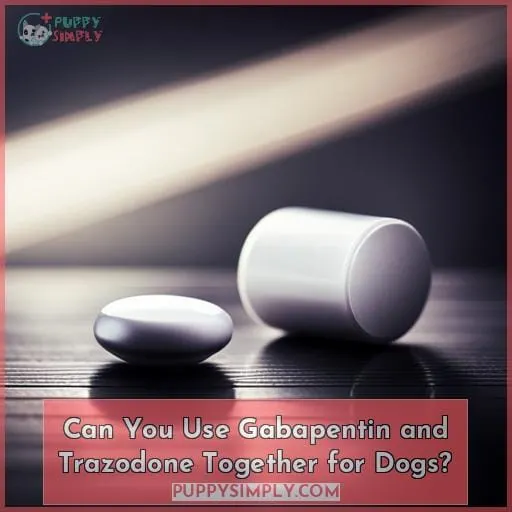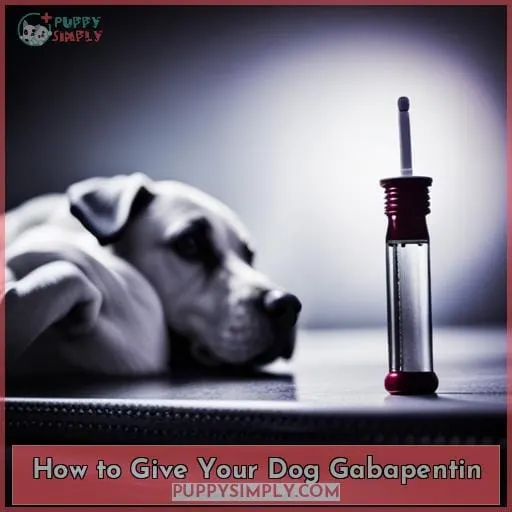This site is supported by our readers. We may earn a commission, at no cost to you, if you purchase through links.
 Over 20% of dogs experience chronic pain at some point. You may wonder if gabapentin could help your pup. This medication can ease various health issues in dogs when prescribed by a vet. Learn key uses, dosages, side effects and more so you can discuss gabapentin with your veterinarian and see if it’s right for your dog’s needs.
Over 20% of dogs experience chronic pain at some point. You may wonder if gabapentin could help your pup. This medication can ease various health issues in dogs when prescribed by a vet. Learn key uses, dosages, side effects and more so you can discuss gabapentin with your veterinarian and see if it’s right for your dog’s needs.
Table Of Contents
- Key Takeaways
- What is Gabapentin for Dogs?
- What is Gabapentin Used for in Dogs?
- What Are the Side Effects of Gabapentin in Dogs?
- What’s the Gabapentin Dosage for Dogs?
- Can You Use Gabapentin and Trazodone Together for Dogs?
- Can Dogs Take CBD and Gabapentin?
- Is Tramadol or Gabapentin Better for Dogs in Pain?
- Is Gabapentin Safe for Dogs?
- How to Give Your Dog Gabapentin
- Frequently Asked Questions (FAQs)
- Can gabapentin be used to treat aggression in dogs?
- Are there any long-term side effects of gabapentin in dogs?
- Can gabapentin be used to treat separation anxiety in dogs?
- How long does it take for gabapentin to start working in dogs?
- Can gabapentin be used in combination with other pain medications for dogs?
- Conclusion
Key Takeaways
- Gabapentin is used to prevent seizures, control pain, and ease anxiety in dogs.
- Gabapentin and trazodone are often used together to manage anxiety in dogs.
- Gabapentin and CBD can be beneficial for dogs individually, but using them together can increase the risk of sedation.
- Gabapentin and tramadol are commonly used to alleviate pain in dogs.
What is Gabapentin for Dogs?
Gabapentin is an anticonvulsant and analgesic medication you’re able to give your dog to help manage pain, seizures, and anxiety. It works by blocking stimulation of the nerve cells, although the exact mechanism isn’t fully understood.
Gabapentin can be used off-label in dogs for various conditions such as:
- Preventing seizures
- Controlling chronic pain associated with degenerative joint disease or arthritis
- Easing anxiety during stressful events like thunderstorms or vet visits.
When it comes to gabapentin dosage for dogs, it varies depending on the specific condition being treated. The medication is available in different forms such as capsules or oral solutions that need to be prescribed by a veterinarian based on your dog’s weight and needs.
While gabapentin is generally considered safe for dogs when used correctly under veterinary supervision, there are potential side effects including sedation and changes in coordination. It’s important to follow proper dosing instructions from your vet and monitor your dog closely while they’re taking this medication.
What is Gabapentin Used for in Dogs?
Gabapentin is used in dogs to prevent seizures, control pain, and ease anxiety.
It has anticonvulsant properties that make it beneficial for adjunctive therapy in dogs with refractory seizures or those whose current medication regime is no longer effective enough.
Additionally, gabapentin provides relief for chronic pain and neuropathic pain associated with conditions like degenerative joint disease and arthritis.
Lastly, it can be used to help alleviate anxiety during thunderstorms or stressful vet visits by decreasing the release of excitatory neurotransmitters in the brain.
Preventing Seizures
To prevent seizures in dogs, veterinarians often prescribe gabapentin as an adjunctive therapy.
Gabapentin works by blocking stimulation of the nerve cells, although its exact mechanism isn’t fully understood.
It can be used to control and manage seizures in dogs with refractory epilepsy or those whose current medication regimen is no longer effective enough.
Controlling Pain
If your dog is experiencing chronic pain, gabapentin can be used to help control it.
Gabapentin is an effective medication for managing nerve pain and providing relief from conditions such as arthritis.
It can be given at varying dosages and frequencies, depending on your dog’s specific needs.
However, like any medication, there may be potential side effects that should be considered when using gabapentin for pain management in dogs.
Easing Anxiety
When using gabapentin for dogs, it can be an effective option to ease anxiety and promote a more relaxed state. It helps decrease the release of excitatory neurotransmitters in the brain, preventing anxiety from building up.
However, it’s important to be aware of potential side effects such as sedation and difficulty with balance or walking.
What Are the Side Effects of Gabapentin in Dogs?
You may experience sedation and potential changes in your dog’s level of sleepiness when using gabapentin.
It’s important to be aware of the possible side effects that could occur while administering this medication to your furry friend.
Here are four common side effects associated with gabapentin use in dogs:
- Sedation: Your dog may appear more tired or drowsy than usual.
- Weight gain: Some dogs may experience an increase in appetite, leading to weight gain over time.
Although rare, long-term use or high doses of gabapentin can potentially lead to liver damage.
It is essential to monitor your dog closely for any signs of these side effects and consult with a veterinarian if you have any concerns about their well-being while on this medication.
What’s the Gabapentin Dosage for Dogs?
To determine the appropriate dosage of gabapentin for your dog, consult with your veterinarian as it will depend on factors such as their weight and the specific condition being treated.
The dosage range for gabapentin varies widely depending on what it’s being used to treat.
Gabapentin is available in several forms that are human-labeled products: 100 mg capsules, 300 mg capsules, and 400 mg capsules. Sometimes a dog is too small to use the human formulations, in which case a compounding pharmacy can formulate whichever form and dosage your veterinarian requests.
Gabapentin is usually given by mouth two to four times per day, with or without food. Check the directions on the bottle or ask your vet if you aren’t sure of the correct dosage for your dog.
| Dosage Range | Frequency |
|---|---|
| 5mg every 12 hours | Two Times Daily |
| 10-30mg every 8 hours | Three Times Daily |
(Source: PetMD)
Can You Use Gabapentin and Trazodone Together for Dogs?
Using gabapentin and trazodone together is a common practice to help manage anxiety in dogs. These two medications can be used in combination to provide effective relief for dogs experiencing anxiety or stress-related behaviors.
Here are some key points about using gabapentin and trazodone together:
- Effective Anxiety Management: Gabapentin and trazodone work synergistically to reduce anxiety levels, promoting a sense of calmness in your dog.
- Complementary Mechanisms of Action: Gabapentin acts on the nervous system by blocking nerve cell stimulation, while trazodone works as an antidepressant by increasing serotonin levels.
- Customized Dosage: The dosage of both medications will depend on your dog’s weight, specific needs, and severity of symptoms. It’s essential to consult with your veterinarian for proper dosing instructions.
- Potential Side Effects: Both gabapentin and trazodone may cause drowsiness or sedation initially; however, these effects typically diminish over time.
By combining the benefits of gabapentin with those offered by trazodone under veterinary guidance,
you can effectively alleviate anxiety symptoms in your furry friend.
Can Dogs Take CBD and Gabapentin?
Now that we’ve discussed the use of gabapentin and trazodone together for dogs, let’s address another common question: Can dogs take CBD and gabapentin?
Many pet owners have turned to CBD as a natural alternative for managing various conditions in their furry friends.
While both gabapentin and CBD can be beneficial for dogs individually, it’s important to exercise caution when considering combining them. Using these two substances together can increase the risk of sedation in your dog.
If your dog is already on gabapentin for pain or anxiety relief prescribed by a veterinarian, it’s crucial to consult with them before introducing any additional medications or supplements such as CBD oil.
They’ll be able to provide guidance on whether this combination is safe based on your dog’s specific needs.
Always prioritize open communication with your veterinarian regarding medication choices for your beloved canine companion.
Is Tramadol or Gabapentin Better for Dogs in Pain?
When considering pain management options for your dog, you may wonder which is more effective: tramadol or gabapentin. Both medications are commonly used to alleviate pain in dogs, but they work in different ways and have different properties.
Tramadol is an opioid analgesic that works by binding to opioid receptors in the brain and spinal cord, while gabapentin is an anticonvulsant and analgesic that works by blocking stimulation of nerve cells.
The half-life of tramadol in dogs ranges from 3-7 hours, meaning it takes this amount of time for half the drug to be eliminated from the body. On the other hand, gabapentin has a much longer half-life ranging from 2-4 hours.
When it comes to dosage guidelines for these medications, both tramadol and gabapentin should be prescribed by a veterinarian based on your dog’s specific needs.
As with any medication, there can be potential side effects associated with both tramadol and gabapentin use in dogs. Common side effects of tramadol include sedation, constipation, dizziness, and vomiting.
Gabapentin, on the other hand, may cause sedation, incoordination, and gastrointestinal upset such as vomiting and diarrhea. It is important to discuss these side effects with your vet before starting treatment.
In terms of cost, the price of tramadol is generally lower than that of gabapentin due to the fact that it is a generic medication. While there are generic forms of gabapentin available, it still tends to be more expensive than generic tramadol.
Though cost should not be a huge factor when considering which medication to choose for pain management in your dog, you should keep it in mind when making your decision.
Is Gabapentin Safe for Dogs?
If your dog has a history of liver disease, seizures, or kidney disease, it’s important to consider whether gabapentin is safe for them.
While gabapentin can be an effective medication for dogs with various conditions like arthritis, anxiety, and cancer-related pain relief; there are potential side effects and interactions that need to be considered.
Serious side effects in dogs are uncommon when gabapentin is used at prescribed doses. However, it’s crucial to avoid overdosing on this medication as it can cause liver damage in dogs.
Common side effects include sedation and loss of coordination.
It’s also important to note that gabapentin may take longer to metabolize in animals with kidney or liver disease.
How to Give Your Dog Gabapentin
To give your dog Gabapentin, simply administer the medication orally according to the prescribed dosage.
Here are some tips on how to give your dog Gabapentin:
- Crushed Tablets: If you have tablets, crush them into a fine powder and mix it with your dog’s food. This will make it easier for them to consume.
- Opened Capsules: For capsules, open them up and sprinkle the contents onto their food. This allows for easy ingestion.
- Give with or without Food: You can give Gabapentin to your dog with or without food, depending on what works best for you and your pet.
- How much to Give: The dosage of Gabapentin varies depending on various factors such as weight and medical condition. Always follow the instructions provided by your veterinarian regarding the appropriate dose for your specific situation.
Remember that consistency is key when administering medication to dogs. It’s important not only in terms of timing but also in ensuring that they receive their full prescribed dose each time.
Frequently Asked Questions (FAQs)
Can gabapentin be used to treat aggression in dogs?
Yes, gabapentin can be used to help treat aggression in dogs. It’s often prescribed as part of a comprehensive treatment plan that may include:
- Behavior modification techniques
- Other medications
Are there any long-term side effects of gabapentin in dogs?
While gabapentin is generally safe for dogs, long-term use may lead to potential side effects such as:
- Sedation
- Loss of coordination
However, it’s important to weigh the benefits against the risks with your veterinarian before making any decisions.
Can gabapentin be used to treat separation anxiety in dogs?
Yes, gabapentin can be used to treat separation anxiety in dogs.
It helps reduce anxiety by decreasing the release of excitatory neurotransmitters in the brain.
Consult with your veterinarian for proper dosage and guidance.
How long does it take for gabapentin to start working in dogs?
Gabapentin typically starts working in dogs within one to two hours of administration.
It provides relief for chronic pain, seizures, and anxiety.
Always consult a veterinarian before discontinuing any medication or starting your dog on additional medications/supplements.
Can gabapentin be used in combination with other pain medications for dogs?
Yes, gabapentin can be used in combination with other pain medications for dogs.
It’s often prescribed alongside nonsteroidal anti-inflammatories or opioids to help manage pain associated with surgery or chronic conditions like arthritis.
Conclusion
Ultimately, gabapentin can be a valuable medication for dogs experiencing chronic pain, seizures, or anxiety.
It’s important to discuss with your veterinarian to determine if gabapentin is the right choice for your pup and to establish the appropriate dosage.
While there may be potential side effects, the benefits of gabapentin can outweigh the risks in many cases.
By following your veterinarian’s instructions and monitoring your dog closely, you can help improve their quality of life and provide them with the relief they need.















